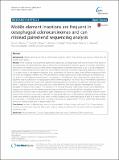Mobile element insertions are frequent in oesophageal adenocarcinomas and can mislead paired-end sequencing analysis
Abstract
Background: Mobile elements are active in the human genome, both in the germline and cancers, where they can mutate driver genes. Results: While analysing whole genome paired-end sequencing of oesophageal adenocarcinomas to find genomic rearrangements, we identified three ways in which new mobile element insertions appear in the data, resembling translocation or insertion junctions: inserts where unique sequence has been transduced by an L1 (Long interspersed element 1) mobile element; novel inserts that are confidently, but often incorrectly, mapped by alignment software to L1s or polyA tracts in the reference sequence; and a combination of these two ways, where different sequences within one insert are mapped to different loci. We identified nine unique sequences that were transduced by neighbouring L1s, both L1s in the reference genome and L1s not present in the reference. Many of the resulting inserts were small fragments that include little or no recognisable mobile element sequence. We found 6 loci in the reference genome to which sequence reads from inserts were frequently mapped, probably erroneously, by alignment software: these were either L1 sequence or particularly long polyA runs. Inserts identified from such apparent rearrangement junctions averaged 16 inserts/tumour, range 0-153 insertions in 43 tumours. However, many inserts would not be detected by mapping the sequences to the reference genome, because they do not include sufficient mappable sequence. To estimate total somatic inserts we searched for polyA sequences that were not present in the matched normal or other normals from the same tumour batch, and were not associated with known polymorphisms. Samples of these candidate inserts were verified by sequencing across them or manual inspection of surrounding reads: at least 85 % were somatic and resembled L1-mediated events, most including L1Hs sequence. Approximately 100 such inserts were detected per tumour on average (range zero to approximately 700). Conclusions: Somatic mobile elements insertions are abundant in these tumours, with over 75 % of cases having a number of novel inserts detected. The inserts create a variety of problems for the interpretation of paired-end sequencing data.
Citation
Paterson , A L , Weaver , J M J , Eldridge , M D , Tavare , S , Fitzgerald , R C , Edwards , P A W & OCCAMS Consortium 2015 , ' Mobile element insertions are frequent in oesophageal adenocarcinomas and can mislead paired-end sequencing analysis ' , BMC Genomics , vol. 16 , 473 . https://doi.org/10.1186/s12864-015-1685-z
Publication
BMC Genomics
Status
Peer reviewed
ISSN
1471-2164Type
Journal article
Description
Funding was primarily from Cancer Research UK program grants to RCF and ST (C14478/A15874 and C14303/A17197), with additional support awarded to RCF from UK Medical Research Council, NHS National Institute for Health Research (NIHR), the Experimental Cancer Medicine Centre Network and the NIHR Cambridge Biomedical Research Centre, and Cancer Research UK Project grant C1023/A14545 to PAWE. JMJW was funded by a Wellcome Trust Translational Medicine and Therapeutics grant.Collections
Items in the St Andrews Research Repository are protected by copyright, with all rights reserved, unless otherwise indicated.

